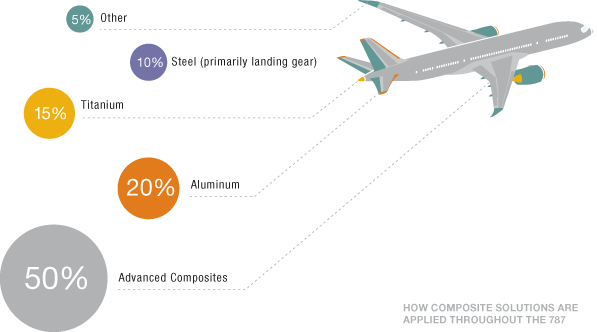
COMPOSITES IN THE AIRFRAME AND PRIMARY STRUCTURE
The Boeing 787 makes greater use of composite materials in its airframe and primary structure than any previous Boeing commercial airplane. Undertaking the design process without preconceived ideas enabled Boeing engineers to specify the optimum material for specific applications throughout the airframe.
The result is an airframe comprising nearly half carbon fiber reinforced plastic and other composites. This approach offers weight savings on average of 20 percent compared to more conventional aluminum designs.
Selecting the optimum material for a specific application meant analyzing every area of the airframe to determine the best material, given the operating environment and loads that a component experiences over the life of the airframe. For example, aluminum is sensitive to tension loads but handles compression very well. On the other hand, composites are not as efficient in dealing with compression loads but are excellent at handling tension. The expanded use of composites, especially in the highly tension-loaded environment of the fuselage, greatly reduces maintenance due to fatigue when compared with an aluminum structure. This type of analysis has resulted in an increased use of titanium as well. Where loading indicates metal is a preferred material system but environmental considerations indicate aluminum is a poor choice, titanium is an excellent low-maintenance design solution. Titanium can withstand comparable loads better than aluminum, has minimal fatigue concerns, and is highly resistant to corrosion. Titanium use has been expanded on the 787 to roughly 14 percent of the total airframe. Every structural element of the 787 has undergone this type of life-cycle analysis and material types are based on a thorough and disciplined selection process.

The right material for the right application. Without preconceived ideas, Boeing engineers were able to specify the optimum material for specific applications throughout the airframe.
In addition to lowering the overall airplane weight, moving to a composite primary structure promises to reduce both the scheduled and nonroutine maintenance burden on the airlines.
In addition to using a robust structural design in damage-prone areas, the 787 has been designed with the capability to be repaired in exactly the same manner that airlines would repair an airplane today — with bolted repairs. These can be just as permanent and damage tolerant as they are on a metal structure.Reduced scheduled maintenance. Experience with the Boeing 777 proves that composite structures require less scheduled maintenance than noncomposite structures. For example, the 777 composite tail is 25 percent larger than the 767’s aluminum tail, yet requires 35 percent fewer scheduled maintenance labor hours. This labor hour reduction is due to the result of a reduced risk of corrosion and fatigue of composites compared with metal.
Reduced nonroutine maintenance. A composite structure also results in less nonroutine maintenance. The 777 floor structure is all composite and highlights the advantages of this material when applied in a harsh environment. Airline operators are aware of the fatigue cracking and corrosion difficulties experienced with traditional aluminum floor beams. The 777 model has been flying for more than 10 years with more than 565 airplanes in the fleet and to date has not replaced a single composite floor beam.
Boeing has also implemented a rigorous process for evaluating the use of aluminum that combines likelihood of corrosion with consequence of corrosion. This scoring system provides a definitive measure for establishing acceptable application of aluminum in the design with full understanding of the maintenance implications.
Corrosion and fatigue in a structure add significantly to the nonroutine maintenance burden on an operator. Nonroutine maintenance frequently doubles or even triples the total labor hours expended during a maintenance check. With the expanded use of composites and titanium combined with greater discipline in usage of aluminum, Boeing expects the 787 to have much lower nonroutine labor costs than a more conventional metallic airframe.
In addition to using a robust structural design in damage-prone areas, such as passenger and cargo doors, the 787 has been designed from the start with the capability to be repaired in exactly the same manner that airlines would repair an airplane today — with bolted repairs. The ability to perform bolted repairs in composite structure is service-proven on the 777 and offers comparable repair times and skills as employed on metallic airplanes. (By design, bolted repairs in composite structure can be permanent and damage tolerant, just as they can be on a metal structure.)
In addition, airlines have the option to perform bonded composite repairs, which offer improved aerodynamic and aesthetic finish. These repairs are permanent, damage tolerant, and do not require an autoclave. While a typical bonded repair may require 24 or more hours of airplane downtime, Boeing has taken advantage of the properties of composites to develop a new line of maintenance repair capability that requires less than an hour to apply. This rapid composite repair technique offers temporary repair capability to get an airplane flying again quickly, despite minor damage that might ground an aluminum airplane.
In total, the reduced risk of corrosion and fatigue associated with composites combined with the composite repair techniques described will lower overall maintenance costs and maximize airline revenue by keeping airplanes flying as much as possible.
